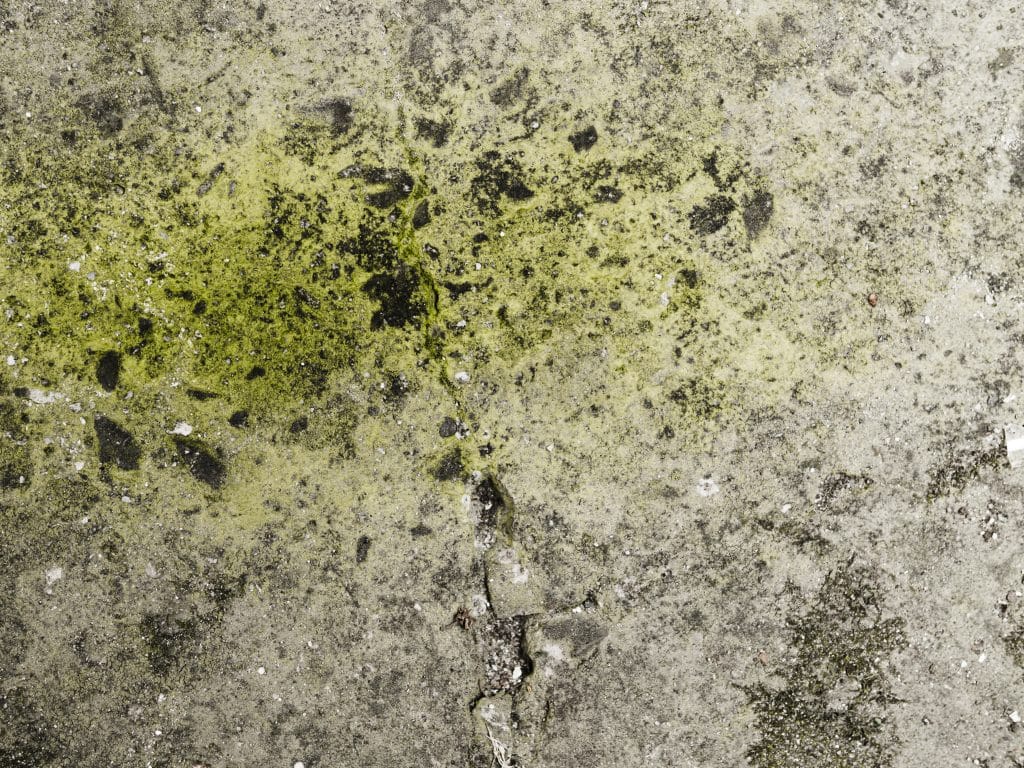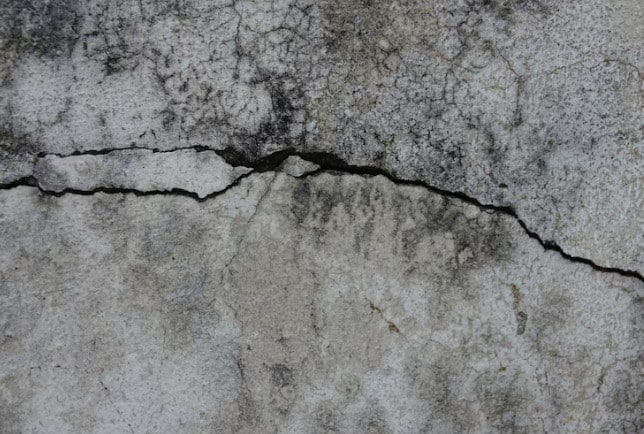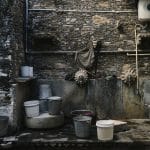Contents
Learning how to fix a foundation leak from the inside helps prevent further damage and maintains your home’s integrity. Identifying all the signs early and using the right methods to seal leaks effectively will help you many times over.
Identifying Hydrostatic Pressure Signs
Water accumulation in the basement after heavy rains is a telltale sign. This symptom suggests that water from saturated soil is pushing against the foundation. It seeks entry through cracks or porous concrete.
Another indicator to watch for is efflorescence on walls. The white, powdery substance results from water evaporating and leaving behind salt deposits. Its presence on basement walls signals that moisture is penetrating the foundation.
Homeowners should also be alert to changes in their basement’s environment. If the floors feel damp or there’s an observable increase in humidity levels, these conditions can indicate hydrostatic pressure problems. High humidity inside a basement often leads to mould and mildew growth, adding health risks to structural concerns.
Detecting Basement Wall Leaks
To spot a leak in your basement walls, start with the obvious signs. Look for visible cracks or wet spots, especially after heavy rainfalls. These are clear indicators of water intrusion.
Rain often exacerbates existing vulnerabilities in your foundation, making leaks more evident. Inspect the walls thoroughly for any such signs. Use a flashlight to observe the base of walls and corners where moisture might hide or cause discoloration unnoticed.
Odour and mould
Musty odours or mould growth on walls signal prolonged moisture presence. These symptoms should not be ignored as they indicate an ongoing issue with water leakage. Mold thrives in damp conditions.

Its presence is a strong indicator that water has been seeping into your basement over time. Detecting mould or a persistent musty smell necessitates immediate action to identify and address the source of moisture.
Locating Foundation Leak Sources
Look for soil erosion or water pooling near the foundation. These are telltale signs of potential leak origins. Soil erosion can undermine the foundation’s stability, leading to cracks through which water can enter.
Gutters and downspouts should direct water away from the foundation. Improper drainage contributes to hydrostatic pressure, exacerbating leak issues.
- Window wells — must be sealed appropriately. Otherwise, they become gateways for water intrusion;
- Plumbing check — differentiate between external leaks and internal plumbing issues. Leaks from pipes can mimic foundational leaks but require different solutions. All internal sources must be ruled out before proceeding with repairs aimed at leaky foundations;
- Interior signs — look for damp spots, efflorescence, or mould growth on walls and floors.
These signs indicate moisture penetration, often due to hydrostatic pressure against the foundation. Identifying these areas helps pinpoint where to focus repair efforts.
Waterproofing the Slab Properly
Applying a concrete waterproofing coating is important. This method involves covering the entire slab with a durable, water-resistant layer. It acts as a barrier against moisture from the ground. Homeowners find this step effective in keeping their basements dry. Once applied, the coating dries to form a seamless barrier that prevents water infiltration.
Vapor barrier
Another method is installing a vapour barrier beneath the basement flooring. This plastic or foil sheeting blocks moisture from reaching the surface, making it an essential layer of protection, especially in areas prone to high humidity.
This barrier works hand-in-hand with exterior waterproofing efforts. Together, they provide comprehensive protection against water damage.
Dehumidifier system
Integrating a dehumidifier system tackles interior humidity levels. High humidity can lead to condensation on cool surfaces like the slab. A dehumidifier removes excess moisture from the air, maintaining a dry environment inside.
This approach is particularly beneficial during warmer months when indoor humidity levels spike.
Improving Drainage Systems
Improving drainage systems is a critical step in how to fix a foundation leak from the inside, especially when dealing with hydrostatic pressure. This pressure builds up when water accumulates around the foundation, leading to potential structural damage over time. A well-thought-out approach can significantly mitigate these risks.
The first line of defence is securing gutters and downspouts are clean and properly installed. They must effectively direct water away from the house. Clogged or misaligned gutters can cause water to spill over, saturating the ground near the foundation.
Installing a French drain system around the perimeter of your home offers another layer of protection. This system intercepts groundwater before it reaches your foundation and redirects it safely away. It’s particularly useful in areas prone to heavy rain or where soil conditions promote water retention.
If water does manage to accumulate inside the basement or crawl space, a sump pump can remove it, reducing internal hydrostatic pressure. Upgrading an outdated or underperforming sump pump guarantees that high volumes of water are handled efficiently.
Clean Window Wells
Homeowners must prioritize keeping window wells free from debris. This includes leaves, twigs, and any other materials that might accumulate. Such clutter can obstruct water flow, leading to accumulation and potential foundation leaks.
Regular inspections help these areas remain clear. This simple and effective step prevents water from pooling against your home’s foundation.
Install covers
Installing window well covers serves dual purposes for homeowners. First, they significantly reduce the amount of water that can collect in window wells during heavy rainfalls. Second, they allow natural light to enter basement spaces without compromising on moisture control.
These covers come in various materials and designs. Each offers different levels of durability and light transmission. Selecting the right cover involves balancing these factors with the specific needs of your home.
Repair cracks
Over time, window wells may develop cracks or gaps through which water can seep into the basement area. Homeowners should inspect these structures regularly for any signs of damage. Early detection and repair are key in preventing minor issues from escalating into major leaks.
Some cracks are more challenging to repair than others, making them significantly more dangerous in the long run. Cracks resulting from hydrostatic pressure can compromise the structural integrity of your home if left unaddressed.

It’s important to understand that not all leaks are straightforward to fix from the inside, particularly when hydrostatic pressure is involved. This situation often requires professional assessment to determine the best course of action for repair. Experts have the tools and knowledge necessary to evaluate the severity of leaks and propose effective solutions.
Using waterproof sealants or engaging professional services that definitely know how to fix a foundation leak from the inside for more extensive repairs guarantees that these vulnerabilities do not compromise your home’s integrity.
Hydrostatic Pressure Solutions
The installation of an interior weeping tile system offers a solution to mitigate hydrostatic pressure. This method entails creating a pathway within the basement to collect water that seeps through due to pressure buildup.
Exterior waterproofing
Exterior waterproofing measures serve as a critical line of defence against hydrostatic pressure-induced leaks. Applying a waterproof membrane or coating on the exterior walls of the foundation provides an impermeable barrier against moisture.
This solution involves excavating around the property to access and treat the foundation walls directly. While more labour-intensive, it delivers long-lasting results by preventing water from ever reaching the interior spaces. Coupled with proper drainage solutions, such as French drains, this strategy significantly reduces the risk of foundation damage.
Conclusion
Review and update your waterproofing and drainage strategies regularly to keep your home protected against hydrostatic pressure. This process includes periodic inspections for signs of moisture accumulation or cracks in the foundation.
Adjustments may involve clearing debris from window wells or upgrading interior drainage systems to handle increased water flow during heavy rainfall seasons. Definitely, use the help of professionals for these purposes.
WillFix, a basement underpinning company takes a personalized approach to waterproofing. They understand that each home is unique and requires tailored solutions. Treating each project as if it were for their own home, they guarantee careful attention to detail and high-quality work.
How to Fix A Foundation Leak from The Inside FAQ
-
What are the steps to improve drainage systems and reduce the risk of foundation leaks?
Clean and properly installed downspouts and gutters effectively channel water away from your home to improve drainage and reduce the risk of foundation leaks.
-
How can I prevent clogged or improperly installed downspouts from affecting the foundation?
Clogged or improperly installed downspouts can cause water to overflow, saturating the ground near the foundation. This can lead to structural damage due to hydrostatic pressure. To prevent this problem, gutters should be cleaned regularly and installed as required.
-
Are there any ways to repair leaks, especially in the case of hydrostatic pressure?
Call in professionals who can pinpoint the cause and offer an effective solution for repairing hydrostatic pressure leaks.
-
Where to look to detect and prevent foundation leaks?
To detect and prevent foundation leaks, you should check drainage, window wells and plumbing leaks and look for interior signs of moisture intrusion, such as damp spots, scale or mould on walls and floors.

